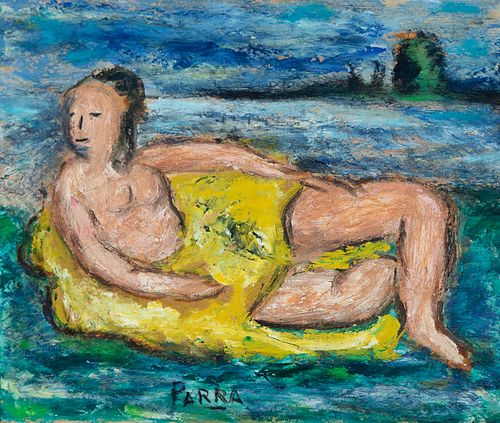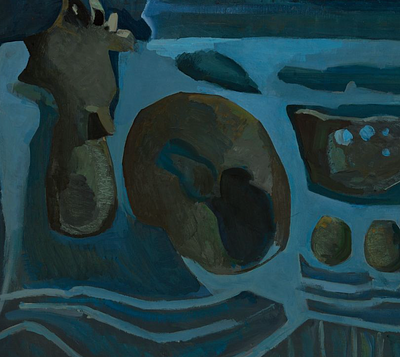GINÉS PARRA (Zurgena, Almería, 1896 - Paris, France, 1960). "On the beach". Oil on canvas. Signed in the lower margin.
Lot 37
About Seller
Setdart Auction House
Carrer Aragó 346
Barcelona
Spain
Setdart Subastas was born in 2004 and is currently the first online art auction in Spain with solidity, prestige and reliability guaranteed by our more than 60,000 users. Setdart has a young, dynamic and enterprising team ready to successfully manage the purchase and sale of art works through custom...Read more
Estimate:
EUR€1,800 - EUR€2,000
$1,875 - $2,083.33
Absentee vs Live bid
Two ways to bid:
- Leave a max absentee bid and the platform will bid on your behalf up to your maximum bid during the live auction.
- Bid live during the auction and your bids will be submitted real-time to the auctioneer.
Bid Increments
| Price | Bid Increment |
|---|---|
| EUR€0 | EUR€10 |
| EUR€200 | EUR€25 |
| EUR€500 | EUR€50 |
| EUR€1,000 | EUR€100 |
| EUR€3,000 | EUR€200 |
| EUR€5,000 | EUR€500 |
| EUR€10,000 | EUR€1,000 |
| EUR€20,000 | EUR€2,000 |
| EUR€50,000 | EUR€5,000 |
About Auction
By Setdart Auction House
Jul 27, 2021
Set Reminder
2021-07-27 08:00:00
2021-07-27 08:00:00
America/New_York
Bidsquare
Bidsquare : CONTEMPORARY AND ACTUAL ART
https://www.bidsquare.com/auctions/setdart-auction-house/contemporary-and-actual-art-7261
Setdart Auction House sofia@setdart.com
Setdart Auction House sofia@setdart.com
- Lot Description
GINÉS PARRA (Zurgena, Almería, 1896 - Paris, France, 1960). "On the beach". Oil on canvas. Signed in the lower margin. Measures: 22,5 x 29 cm; 47,5 x 53 cm (frame). Ginés Parra, whose real name was José Antonio Ramón Parra Menchón, spent his childhood in Algeria, working with his father as a miner. After several trips to Argentina and other South American countries between 1910 and 1916, he moved to the United States. He worked in copper mines in Arizona and later settled in Los Angeles. He soon moved to New York, where he began taking classes at the Students League. He later began his art studies at the National Academy School of Fine Arts in the same city, although he was forced to continue working in the subway and as a waiter to survive. Around 1920 he settled in Paris, in a studio in the Montparnasse district, to continue his training at the École Nationale Supérieure des Beaux-Art. In the early days he continued, as always, to work on the fringes of art, this time as a car washer and grocer. However, soon after he made contact with other painters such as Pablo Picasso, Julio González or Manuel Ángeles Ortiz, and with them he participated in various exhibitions, such as the Society of French Artists, the Salon d'Automne or the Salon des Indépendants. In 1922 he exhibited with Joaquín Roca at the Du Taureau Gallery in Paris and, soon after, one of his most praised works at the Salon des Indépendants, "Leda and the Swan", was acquired by a gallery in Boston. Between the thirties and forties his fame was established and he distinguished himself as a member of the New School of Paris. However, due to economic problems he was forced to dispose of his extensive art collection, which included works by Degas, Modigliani, Guillaumin and Picasso himself. The outbreak of the Civil War surprised Ginés Parra in Madrid, where he decidedly aligned himself with the Republican side, for which he was imprisoned. He only regained his freedom thanks to the intercession of Pancho Cossío. In the following years he travels several times to Spain, and exhibits in various cities in Europe and America: in Prague in 1946, Brussels and Stockholm in 1947, London, Lima, Sao Paulo, Mexico City, Havana, Buenos Aires... He also continues to hold exhibitions in Paris, and in 1959 he exhibits with Picasso at the Trouche gallery, and with Oscar Dominguez in Brittany. That same year he was diagnosed with cancer and, after several months of illness, he died in Paris in April 1960. Shortly after, the Salon des Indépendants dedicates an anthological exhibition to him, and Picasso and other friends create the Society of Friends of Parra. He is represented in the Narodni Muzeum in Prague, the Mosavska Galerie in Brno (Czech Republic), the Museums of Fine Arts in Boston and Havana, the Museum of Art in São Paulo, the Patio Herreriano Museum of Contemporary Art in Valladolid and the ARTIUM in Vitoria, among others.
- Shipping Info
-
In-house shipping available. Please inquire at admin@setdart.com.
-
- Buyer's Premium



 EUR
EUR CAD
CAD AUD
AUD GBP
GBP MXN
MXN HKD
HKD CNY
CNY MYR
MYR SEK
SEK SGD
SGD CHF
CHF THB
THB















